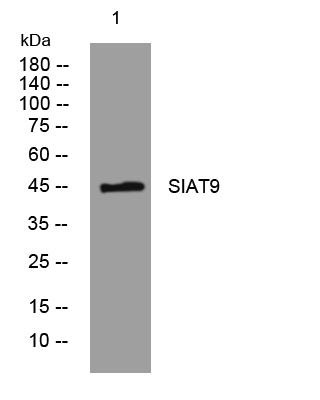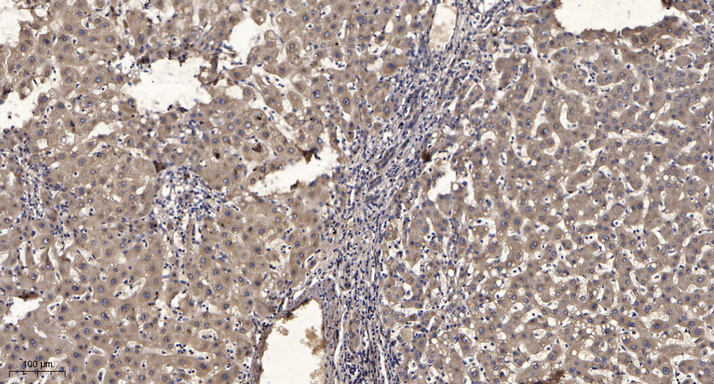SIAT9 rabbit pAb
- Catalog No.:YT7652
- Applications:WB;ELISA;IHC
- Reactivity:Human;Mouse;Rat
- Target:
- SIAT9
- Fields:
- >>Glycosphingolipid biosynthesis - ganglio series;>>Metabolic pathways
- Gene Name:
- ST3GAL5 SIAT9 UNQ2510/PRO5998
- Protein Name:
- SIAT9
- Human Gene Id:
- 8869
- Human Swiss Prot No:
- Q9UNP4
- Mouse Gene Id:
- 20454
- Mouse Swiss Prot No:
- O88829
- Rat Gene Id:
- 83505
- Rat Swiss Prot No:
- Q68G12
- Immunogen:
- Synthesized peptide derived from human SIAT9 AA range: 157-207
- Specificity:
- This antibody detects endogenous levels of SIAT9 at Human/Mouse/Rat
- Formulation:
- Liquid in PBS containing 50% glycerol, 0.5% BSA and 0.02% sodium azide.
- Source:
- Polyclonal, Rabbit,IgG
- Dilution:
- WB 1:500-2000;IHC 1:50-300; ELISA 2000-20000
- Purification:
- The antibody was affinity-purified from rabbit antiserum by affinity-chromatography using epitope-specific immunogen.
- Concentration:
- 1 mg/ml
- Storage Stability:
- -15°C to -25°C/1 year(Do not lower than -25°C)
- Molecular Weight(Da):
- 46kD
- Background:
- Ganglioside GM3 is known to participate in the induction of cell differentiation, modulation of cell proliferation, maintenance of fibroblast morphology, signal transduction, and integrin-mediated cell adhesion. The protein encoded by this gene is a type II membrane protein which catalyzes the formation of GM3 using lactosylceramide as the substrate. The encoded protein is a member of glycosyltransferase family 29 and may be localized to the Golgi apparatus. Mutation in this gene has been associated with Amish infantile epilepsy syndrome. Transcript variants encoding different isoforms have been found for this gene. [provided by RefSeq, Jul 2008],
- Function:
- catalytic activity:CMP-N-acetylneuraminate + beta-D-galactosyl-(1->4)-beta-D-glucosyl-(1<->1)-ceramide = CMP + alpha-N-acetylneuraminyl-(2->3)-beta-D-galactosyl-(1->4)-beta-D-glucosyl-(1<->1)-ceramide.,disease:Defects in ST3GAL5 are the cause of Amish infantile epilepsy syndrome (AIES) [MIM:609056]. AIES is an autosomal recessive, infantile-onset symptomatic epilepsy associated with developmental stagnation and blindness.,function:Catalyzes the formation of ganglioside GM3 (alpha-N-acetylneuraminyl-2,3-beta-D-galactosyl-1, 4-beta-D-glucosylceramide).,online information:GlycoGene database,online information:ST3Gal V,PTM:N-glycosylated.,similarity:Belongs to the glycosyltransferase 29 family.,tissue specificity:Ubiquitous. High expression in brain, skeletal muscle, placenta, and testis.,
- Subcellular Location:
- Golgi apparatus membrane ; Single-pass type II membrane protein .
- Expression:
- Ubiquitous. High expression in brain, skeletal muscle, placenta, and testis. mRNA widely distributed in human brain, but slightly elevated expression was observed in the cerebral cortex, temporal lobe, and putamen.
- June 19-2018
- WESTERN IMMUNOBLOTTING PROTOCOL
- June 19-2018
- IMMUNOHISTOCHEMISTRY-PARAFFIN PROTOCOL
- June 19-2018
- IMMUNOFLUORESCENCE PROTOCOL
- September 08-2020
- FLOW-CYTOMEYRT-PROTOCOL
- May 20-2022
- Cell-Based ELISA│解您多样本WB检测之困扰
- July 13-2018
- CELL-BASED-ELISA-PROTOCOL-FOR-ACETYL-PROTEIN
- July 13-2018
- CELL-BASED-ELISA-PROTOCOL-FOR-PHOSPHO-PROTEIN
- July 13-2018
- Antibody-FAQs
- Products Images

- Western blot analysis of lysates from HpeG2 cells, primary antibody was diluted at 1:1000, 4°over night

- Immunohistochemical analysis of paraffin-embedded human liver cancer. 1, Antibody was diluted at 1:200(4° overnight). 2, Tris-EDTA,pH9.0 was used for antigen retrieval. 3,Secondary antibody was diluted at 1:200(room temperature, 45min).



